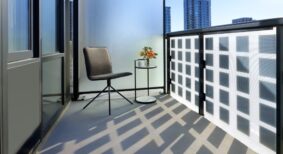Balconies with built-in solar panels, smart lighting that mimics sunlight, and air filters that remove indoor pollutants on demand. These are just a few amenities on display at The Well’s new self-powered condo unit in downtown Toronto.
The Current Suite, as it’s called, is located on the 22 floor of Tridel’s Classic Series II property at Front Street and Spadina Avenue. The 1,080-square-foot residence is said to be the developer’s most eco-friendly model yet—where health and wellbeing meets reduced energy use and carbon emissions through innovative technologies.
Graeme Armster, Tridel’s director of innovation and sustainability, says the design builds upon lessons learned from three previous innovation suites, one of which is located in the developer’s first smart condominium, 10 York; another in Aqualina at Bayside, the first high-rise condo in Toronto to earn LEED Platinum certification.
“The world is trying to transition to lower carbon energy sources, which right now means electrifying as much as possible,” he says. “The concern is that, as we add more to the grid, we have to manage it more effectively and that’s where the energy efficiency comes in.”
A solar-powered battery can supply half of the suite’s daily electricity consumption. Solar panels take up a seamless spot on the balcony railings and power a battery storage system, which feeds all the indoor HVAC equipment and LED lighting with DC power. The battery can provide up to 10 hours of electricity during power outages and charge overnight during off-peak hours.
“We have the ability to consume free energy from the solar or cheap energy at two cents per kilowatt-hour, if you’re on an ultra low off-peak program,” said Armster. “ The savings are quite drastic.”
A power-over-ethernet system, which has traditionally been used for distributing the internet, sends data and electricity to devices around the home, bringing various control capabilities like customizable LED fixtures that match ambient lighting to human circadian rhythms.

Classic Series 2 condo at The Well. Photo by Tridel.
Light and temperature are primary synchronizers of the body’s circadian rhythm, which regulates the sleep-wake cycle and is tied to a person’s 24-hour body clock.
“In the morning, the sun rises and delivers warmer orange-yellow hues, which wake us in a calm fashion,” explains Armster. “By noon, you start to get those colder white lights that are bright. The orange hues keep us relaxed; the blue cold light keeps us focused and awake. We have the ability to control that in the suite.”
Once occupants program their longitude and latitude, indoor lighting will naturally match all the colours of the sun according to its location and allow for remote control. A “good morning” mode will open blinds and prompt light fixtures to create the feel of a rising sun. This is particularly beneficial during dark winter days. Another feature breaks occupants out of their circadian rhythms; for instance, creating white light for focused work sessions after sunset.
To deliver heating and cooling to the suite, a multi-flow fan coil unit works more efficiently using a six-way valve. Typically, the fan blows air through two coils when only one is being used to heat or cool. In this case, one of the coils is omitted and the valve connects to a smart thermostat.
“That thermostat will tell the valve to send hot water or cold water to the coil. Now, we’re using a single coil to deliver either heating or cooling,” explains Armster. “Less material means less embodied carbon, it’s more energy efficient and saves money.”
In place of a gas-powered boiler, a smart electric hot water heater in the suite allows for remote monitoring and control, while a heat pump dryer prevents exterior venting and improves air tightness. To further reduce energy waste, during the contraction phase, a blower door test assessed where air leakage was occurring. A spray gun then shot out fine particulate matter to plug up those crevices and holes, improving the air tightness of the suite by 50 per cent, while boosting air quality and preventing sound and odour infiltration.

In the kitchen, a ventless range hood and charcoal filter eliminate the need for exterior venting. Photo by Tridel.
An energy recovery ventilator (ERV) exchanges air to ventilate the suite. In this case, the ERV is connected to a sensor that measures CO2 levels. “If the CO2 gets too high the ERV kicks on,” explains Armster. ““It’s right-sizing the solution for the problem. We’re getting perfect ventilation in the unit and perfect air quality and oxygen levels without comprising energy.”
On top of that, a separate sensor, tied directly to a charcoal hepa filter, measures volatile organic compound levels and particulate levels. The system runs high or low depending on the indoor air quality.
Yet another feature is a wastewater heat recovery system that captures and repurposes thermal energy from sanitary drainage.
Coils around the drain absorb heat from flowing hot water and pre-heat the incoming cold water before it reaches the hot water tank, minimizing energy waste.
Cutting Carbon
Due to carbon intensive features like solar panels and batteries the suite had slightly higher emissions from the start. Yet other components, such as the electric hot water tank, reduce carbon. “Just through your operational savings, when you hit the 105-day mark of living in this unit, you’ll start to have a lower carbon footprint than your neighbour or other average condo units in the city,” says Armster.
The plan is to sell the condo unit and retrieve feedback and real testing data to enhance other projects. “We’re so happy with some of these features that we’re going to roll them into future developments,” says Armster. “We’ve already learned a lot.”





